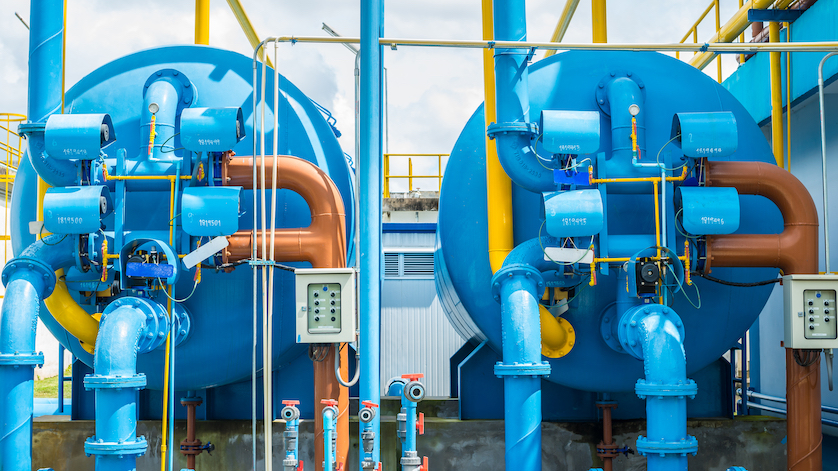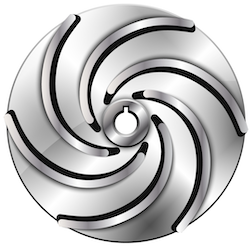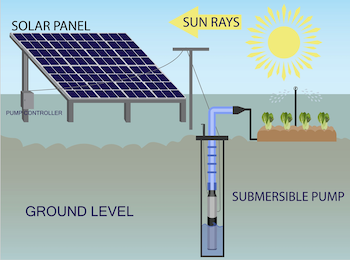
Pumps are essential equipment in any system that moves fluids from point A to point B. In an organism, the heart sends wanted materials (oxygen, nutrients) to various parts of the body and carries away unwanted materials (carbon dioxide, waste). Pumps in wastewater facilities do something similar:
- Add the correct amounts of various chemicals to:
- Remove nutrients and other unwanted components
- Disinfect by killing parasites, bacteria, and viruses
- Adjust the pH to improve the taste and minimize pipe corrosion
- Fluoridate drinking water for stronger teeth
- Remove sludge from sedimentation tanks for further treatment and disposal
In distribution systems, pumps discharge water under pressure to the pipe network and lift it to a higher elevation, such as water towers.
When properly operated and maintained, pumps provide reliable, efficient service for many years.
Types of Pumps in Municipal Water Treatment Plants
Different applications call for different types of pumps, depending on the system requirements, desired discharge pressure, desired flow capacity, and available space. A typical wastewater treatment plant uses three types of pumps:
- Centrifugal pumps
- Submersible pumps
- Positive displacement pumps

Components of a centrifugal pump
Centrifugal pump
This type of pump uses centrifugal force to create sufficient velocity to move liquids. In a municipal water facility, centrifugal pumps move raw wastewater, influent wastewater, primary and secondary sludge, and effluent wastewater.
The wastewater or sludge enters the pump via the suction nozzle and encounters the impeller, a fan-like rotor fitted in a casing and mounted on a horizontal shaft; an electric or diesel motor rotates the shaft. The liquid enters through the impeller’s eye (central hole). As the impeller spins, it whips the liquid out radially, gaining kinetic energy as it centrifuges outward. The spiral-shaped casing slows down the water, converting the velocity head to a pressure head as fluid moves out through the discharge nozzle. A seal or packing rings prevent leakage.
Impellers come in three types: enclosed, semi-open, and open. The more occlusive the medium, the more open the impeller’s vanes should be.

Semi-open impeller
Centrifugal pumps can generate a variety of flow rates and outlet pressures, both of which are dependent on the pump’s size, the space between the impeller and the casing, and the rotational speed. Some pumps are standalone units, while others are connected in a series to generate more output pressure. In such multistage pumps, the desired pressure determines the number of stages required; each stage can achieve an output pressure of up to 250 feet.
Centrifugal pumps are popular in water treatment plants for several reasons:
- The ability to move large volumes of water at a constant output pressure
- Versatility, handling capacities from a few gallons per minute (gpm) to 50,000 gpm
- Uniform flow and output speed with pressure heads of 5 feet to 700 feet
- Functions reliably even when suspended matter are present in the water
- Simple technology and low to moderate initial costs

Submersible pump
Submersible pump
As the name implies, a submersible pump is used below water level, and its primary purpose in a treatment plant is to bring in fresh water from a lake, river, reservoir, or well. It is essentially a multistage centrifugal pump in one piece of equipment. Multiple impellers, mounted on a single shaft and installed vertically, pass water up the pump. Diffusers placed above each impeller ensure that water flows vertically to the next stage. The desired output pressure determines the number of impeller–diffuser stages in a submersible pump; more stages equal greater pressure.
Driving the pump is a waterproof submersible motor powered by either the electrical grid or solar panels. The wiring is similarly waterproof.
Positive displacement pump

Single-action reciprocating pump
Unlike a centrifugal pump, which converts rotational energy to kinetic energy, a positive displacement (PD) pump uses the mechanical energy of a constantly moving element to transfer fluid from the pump’s cavity to its next destination. There are two basic types of positive displacement pumps: reciprocating and rotary.
Reciprocating pumps have a piston that moves back and forth or up and down within an enclosed cylinder. If liquid is displaced during the forward stroke only, the pump is single action; if displacement occurs at both the forward and return stroke, the pump is double acting.
The liquid enters the cylinder via the suction pipe and through a check valve. The assembly of the piston, piston rod, joint, and connecting rod pushes the volume to the delivery pipe via another check valve. Since the motion is reciprocating, the positive displacement of liquid is uneven; a damper can smooth out the flow.

Rotary pump with gears (left) and lobes (right)
Most PD pumps are rotary pumps, where liquid is displaced out of the cavity by means of an impeller. This impeller can be in the form of a gear, lobes, screw, or blade, and moves in a smooth circular motion. The result is steady fluid displacement with each revolution of the shaft.
PD pumps are not suitable for moving large volumes of liquid, but they do excel at low-flow service, and each type has its place in water supply operations.
- Reciprocating pumps are found in applications where very high pressures are required. They are also good for pumping corrosive, abrasive, or viscous liquids, including all types of sludge and slurries.
- Rotary pumps are better suited for lower pressures due to slippage at higher pressures. Though they tend to jam if solids enter the small clearance spaces between the impeller and its casing, fluids of varying viscosities are not an issue. Rotary pumps are used for chemical dosing during various stages of the treatment process.
This article continues with “Measuring Instruments to Monitor Wastewater Pumps for Safety, Performance, and Savings.”


I find the article very informative on Water Pumps